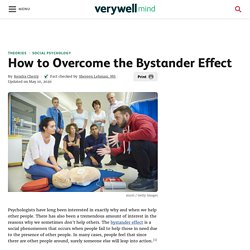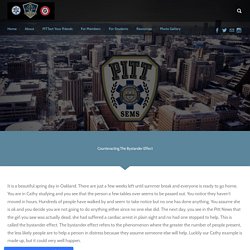

When people are faced with the real emergency situation that is happening right before their eyes, psychologists suggest that whether or not those people actually initiate to help might depend on how many witnesses are present at the scene. What Is the Bystander Effect? If you witnessed an emergency happening right before your eyes, you would certainly take some sort of action to help the person in trouble, right?

While we might all like to believe that this is true, psychologists suggest that whether or not you intervene might depend upon the number of other witnesses present. What Is the Bystander Effect? The term bystander effect refers to the phenomenon in which the greater the number of people present, the less likely people are to help a person in distress. When an emergency situation occurs, observers are more likely to take action if there are few or no other witnesses. Being part of a large crowd makes it so no single person has to take responsibility for an action (or inaction). In a series of classic studies, researchers Bibb Latané and John Darley found that the amount of time it takes the participant to take action and seek help varies depending on how many other observers are in the room. The Kitty Genovese Case. The Bystander Effect in Comic. Bystander Effect: What Is It and What You Can Do About It.
What the bystander effect looks like A little after 3 a.m. on March 13, 1964, Catherine “Kitty” Genovese parked her car and walked to her apartment in Queens, New York, after finishing her shift as a bar manager. Serial killer Winston Moseley was out to victimize someone that night. Genovese became his target. When he followed her, she ran. As Moseley reached her and began stabbing her with a hunting knife, Genovese screamed, “Oh, my God, he stabbed me! When lights in surrounding apartments flipped on and one man called out his window, the attacker ran and hid in the shadows. There was widespread public condemnation of the witnesses who did not come to Kitty Genovese’s aid. The related terms “bystander effect” and “diffusion of responsibility” were coined by social psychologists as a result of this research. The bystander effect describes situations in which a group of bystanders witness harm being done, yet do nothing to help or stop the harmful activity.
According to the U.S. The Science of Empathy. THE BYSTANDER EFFECT. (127) The Bystander Effect: Why Some People Act and Others Don't. Bystander effect - Diffusion of responsibility. Bystander Intervention in Emergencies: Diffusion of Responsibility. The bystander effect and social control behavior. Bystander Effect Compilation (Diffusion of Responsibility) Diffusion of Responsibility: Bystander Effect. How to Overcome the Bystander Effect.
Psychologists have long been interested in exactly why and when we help other people.

There has also been a tremendous amount of interest in the reasons why we sometimes don't help others. The bystander effect is a social phenomenon that occurs when people fail to help those in need due to the presence of other people. In many cases, people feel that since there are other people around, surely someone else will leap into action.1 While the bystander effect can have a negative impact on prosocial behavior, altruism and heroism, researchers have identified a number of different factors that can help people overcome this tendency and increase the likelihood that they will engage in helping behaviors.2 Some of these include: Witnessing Helping Behavior Sometimes just seeing other people doing something kind or helpful makes us more willing to help others.
Imagine that you are walking into a large department store. Being Observant Being Skilled and Knowledgeable Guilt Feeling Good. How To Counteract The Bystander Effect - University of Pittsburgh Student EMS. Counteracting The Bystander Effect It is a beautiful spring day in Oakland.

There are just a few weeks left until summer break and everyone is ready to go home. You are in Cathy studying and you see that the person a few tables over seems to be passed out. You notice they haven't moved in hours. Hundreds of people have walked by and seem to take notice but no one has done anything. Return To PITTect Your Friends HomePage Create your own unique website with customizable templates. Get Started. Breaking the silence - preventing harassment and sexual misconduct. Be an Active Bystander We can all be bystanders. Every day events unfold around us. At some point, we will register someone in danger. When this happens, we will decide to do or say something (and become an active bystander), or to simply let it go (and remain a passive bystander).
When we intervene, we signal to the perpetrator that their behaviour is unacceptable. Learning to recognise when someone is in danger and how you can intervene safely is an essential skill. How to be an Active Bystander: Sometimes, a situation just does not feel right. Breaking the Silence Poster. Bystander Effect Poster. Active bystander. BYSTANDER INTERVENTION.